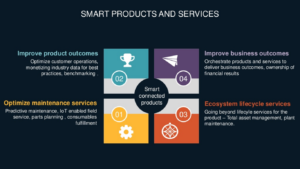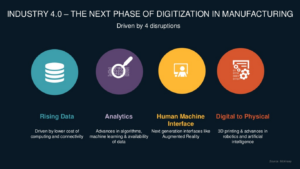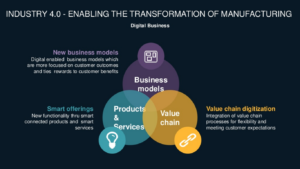Ushering in the next wave of innovation in supply chain through IoT
Published: July 22, 2016
Damodar Sahu
Partner – IoT, Smart Manufacturing & Services, Manufacturing & Technology BU
Wipro Limited
An organization’s supply chain is integrally linked to its successful growth, and with mounting pressure to deliver multiple, often conflicting objectives of cost optimization, flexibility, and excellent customer service, enterprises often struggle to manage all the inherent trade-offs and complexities. An integrated supply chain operations strategy is imperative for enterprises to manage these trade-offs.
Being an experienced supply chain consultant can help you meet your business goals through their deep experience and established methodologies to assess, define and implement enabling supply chain capabilities (people, process, and technology) to meet business objectives tackling Supply Chain pressures driven by rising raw material prices, margin pressures, changing business models and growth in price sensitive emerging markets.

A complex world, with follow-the-sun supply chains, hyper-connected partners and expectation of an exceptionally responsive service has pushed organizations to redefine how they run and measure their supply chains. With top line growth plateauing, there is more scope for organizations to increase profitability by optimizing their supply chains and analytics is fast emerging as a key enabler to do so. The use of business analytics in supply chain processes has become more prevalent over the years. Organizations want to get insights and make data-driven decisions, instead of working on best-guess operations.

To enable clients to enhance their operational performance and add revenue streams, we are exploring digital supply chain. This explores levers that help in enhancing the performance of supply chain in areas such as warehouses, logistics, inventory management, shop floor management and new product development. The holistic offering enables client realize the benefits through our rigorous execution framework running across the spectrum from business & process consulting, device engineering, system integration, analytics to managed services.
Digital Supply Chain
Digital Supply Chain services help an organization through these features:
- Senses information and provides a real time view of the extended enterprise
- Provides collaborative platforms and integrated best practices
- Improve operational excellence, productivity and customer experience
- Provides real time visibility into the supply chain
Move from products to Services – Do advanced inventory optimization and spare parts planning capabilities to support this change and drive better CSAT through a combination of business process change and technology solutions.
Grow in emerging markets and tackle demand stagnation in mature markets -Enable Supply Chain network design capabilities to optimally rebalance the Supply Chains and drive cost efficiencies and Supply Chain agility.
Harmonize process and technology in the era of joint ventures and M&A – Bring consulting experience and proven assets to drive process harmonization and best in class technology enablement and ensure that you are able to deliver the business case.

Traversing The Digital Journey: A Guide for Supply Chain Owners
In recent decades, supply chains have relentlessly approached digital maturity. But transformation to digital is not just another level of improvement – it’s a quantum jump. It’s imperative that organizations understand the full implications and journey required. This article provides insight to customer-front technologies and trends shaping supply chains, explicates the digital journey by defining a digital scorecard, and outlines the progressive stages of digital maturity.
A set of new technologies is shaping today’s supply chain. Beginning with the Internet-of-Things (IoT), real time sensorial data on the geographical position and electromechanical data of entities can radically improve tactical decision-making. Wearables further empower supply chain operators.
As consumers share buying experiences on social media, supply chain managers can access Big data analytics to gain meaningful consumer insights. 3D printing will change the dynamics of production and supply. NASA’s Made in Space wrench is a seeding example. Mobility complemented with cloud computing makes more nodes accessible, increasing data visibility across all echelons. Robots can fully automate warehouses while drones are being tested for deliveries. There’s no doubt that the each technology has its own advantages but for most supply chain operators, the question remains as to which to implement.
Consumers are increasingly demanding more value and highly individualized products where expected turnaround times are shrinking. As customer demands become less predictable, supply chains must be more responsive, agile and resilient.
The method of approach to converting a digitalization vision into operational strategy is crucial. The first step is determining the correct parameters for assessing the supply chain digitalization front. Typically, supply chain managers gauge success on getting the right product at the right place, right time, and right cost. These are often complemented by drill down indicators – fill rates, adaptability, productivity and efficiency. While these conventional parameters do gauge supply chain performance, they can’t evaluate the level of digitalization. Digital parameters are required, to not only measure the internal aspects of supply chain, but assess it from the perspective of stakeholders:
- Visibility: The ability to fetch a single truth of data from all relevant nodes
- Collaboration: A determining factor which indicates the propensity and potential to partner with multiple stakeholders in a complementary way, achieving a common objective.
- Agility: The ability to make a strategic and tactical shift based on market needs.
- Experience: The quality of experience delivered to all stakeholders – from vendors to customers.
- Simplicity: From defining strategy to operating physical and IT processes – all must be executed with simplicity.
Once a supply chain assesses its digital readiness, it can then safely commence its journey. While Digital is the pinnacle of the supply chain maturity matrix, its maturity can be further understood, based on the level of integration of digital enablement:
Augmented: The digitalization journey starts with making incremental changes to the existing system. The core system remains but additional digital components enhance the performance. At this stage, the focus is on internal nodes of the supply chain under the organization’s control. Digital parameters, in their most modest form are defined and measured quantitatively.
Adjacent: At this stage, a select set of digital levers are imbibed into the supply chain processes, becoming integral to operations. Digital initiatives are introduced into the supply chain organization culture. The umbrella of digital levers also starts to incorporate external entities including key vendors, partners and other stakeholders.
Integral: This is the ultimate stage in the transformation curve. Digital is core to the business model, processes and culture. By the time a supply chain reaches this stage, digital is imbibed in the majority of the processes. The supply chain has delivered significant benefits to consumers and improved internal measures. Digital parameters are tightly monitored and reported as part of the executive dashboard.
Supply chain managers often ask what the view from mountain may look like. Here is a sneak peek via key supply chain processes:
- Digital Planning is more collaborative with significantly reduced planning cycle time. Multi-source and sub-transactional data analyzed by various tools makes planning process agile.
- Digital Sourcing has, at its core, comprehensive demand aggregation. Multiple commercial models on shared logistics are available.
- Digital Manufacturing is largely on-demand with modularization, robotics and automation at the core. Delayed differentiation of product deliveries supports mass customization.
- Digital Delivery is more experiential throughout all the touch points in the supply chain. There is an accurate view of true cost to serve integrated into planning, thereby decentralizing the tactical decision making process.
- Digital Returns/ Service are completely prognostic due to high visibility. Collaborative models with stakeholders increase the service network reach, creating higher aftermarket revenues.

The journey of becoming a digital supply chain is systematic. Beginning with defining a digital scorecard, the three stages of maturity must be accurately assessed and traversed. At the pinnacle of transformation, digital planning to service processes completely transform – becoming truly collaborative, visible, agile, experiential and definitely simple in their operation.



